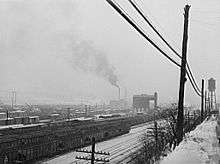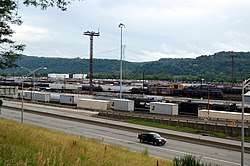Conway Yard
Conway Yard (also known as Conway Terminal) is a major rail yard located in the boroughs of Conway and Freedom, Pennsylvania, 22 miles (35 km) northwest of Pittsburgh, along the Ohio River. It was the largest freight yard in the world from 1956 until 1980.[1][2] It is currently owned by Norfolk Southern (NS) and one of the largest yards in the United States.

History

Conway Yard was initially built by the Pittsburgh, Fort Wayne and Chicago Railway, a subsidiary of the Pennsylvania Railroad (PRR), in 1884,[3] and expanded in the early 20th century. In 1905, it had a capacity of 8,967 cars and typically processed 2,300 cars per day.[4] The enlarged yard was one of four built in Pennsylvania at that time as part of a major PRR expansion, the others being Altoona Yard, Enola Yard, and Harrisburg Yard.[5]
The PRR began rebuilding the yard in 1953. After an investment of $35 million ($334.5 million today), the new eastbound yard opened in 1956, while the rebuilt westbound facilities opened in stages during 1957 and 1958.[6]:8 Its newly expanded capacity was 9,000 cars per day, the largest in the United States, surpassing Enola Yard. Conway was rebuilt with both eastbound and westbound hump classification yards, and a total of 99 classification tracks, at a cost of about $35 million, according to a 1957 PRR publication.[7] A 1958 publication describes a total of 107 classification tracks. The westbound hump yard was outfitted with an automatic control system called VELAC, which was designed and installed by the Union Switch and Signal Company.[8] It was described as the "world's largest push-button yard."[7] The eastbound hump yard was installed with semi-automatic operation.[5] A terminal for transferring coal from river barges to rail cars was located at the south end of the yard.[6]:11
Current operation

Of the aforementioned PRR yards, Conway is the only remaining large operation. NS processes 90,000 to 100,000 cars per month (as of 2003). The site currently occupies 568 acres, with 181 miles (291 km) of track and a storage capacity of over 11,000 cars.[5]
As of 2012, the yard employed 1,400 rail workers, with 60 to 80 trains traveling through it daily.[9]
See also
References
- Edwin Kraft, "The Yard: Railroading's Hidden Half." Trains Magazine, Vol. 62, No. 6, June 2002. p. 48.
- Borkowski, Richard C. (2008). Norfolk Southern Railway. Minneapolis, MN: Voyageur Press. p. 116. ISBN 9780760332498.
- Schafer, Mike; Solomon, Brian (2009). Pennsylvania Railroad. Minneapolis, MN: MBI Publishing. p. 57. ISBN 9780760329306.
- Cushing, W.C. (1905-05-12). "Progress in Yard Design". The Railroad Gazette. XXXVIII (19): 486.
- Rhodes, Michael (2003). North American Railyards. Minneapolis, MN: MBI Publishing. p. 146. ISBN 9780760315781.
- Pennsylvania Railroad (PRR), Philadelphia, PA (1957). "Board of Directors Inspection Trip." Report.
- PRR (1957). "Conway Yard on the Pennsylvania Railroad." Brochure.
- PRR and Union Switch and Signal Co., Swissvale, PA (1958). "Conway Yard." Bulletin 172.
- Fontaine, Tom (2012-05-06). "Railroad companies seeking improvements, 15,000 new hires". Pittsburgh Tribune-Review.